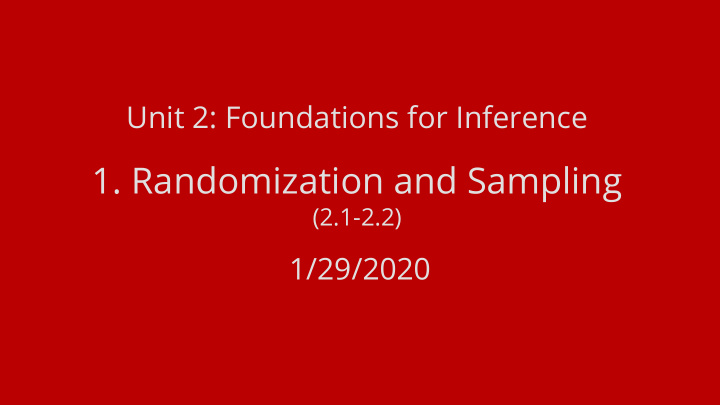



Unit 2: Foundations for Inference 1. Randomization and Sampling (2.1-2.2) 1/29/2020
Recap from last time 1. Good visualizations help you understand your data 2. Descriptive statistics compress data so you can communicate about it 3. The “right” statistics depend on the shape of the data
Remembering Left/Right Skew Thanks, @jasoneggerman!
Quiz 2 - Exploratory data analysis
Key ideas 1. We generally don’t want to make claims about samples, we want to make claims about populations (or the processes that generated the samples) 2. We can use randomization to ask what inferences our sample license about the population 3. We are always talking about degrees of evidence. We can never have certainty.
Case study: Gender discrimination In 1972, as a part of a study on gender discrimination, 48 male bank supervisors ● were each given the same personnel file and asked to judge whether the person should be promoted to a branch manager job that was described as “routine”. The files were identical except that half of the supervisors had files showing the ● person was male while the other half had files showing the person was female. It was randomly determined which supervisors got “male” applications and which ● got “female” applications. Is this an observational study or an experiment? Experiment Rosen & Jerdee (1974, Journal of Applied Psychology)
The results Does it look like there is a relationship between gender and promotion? 87.5% of men promoted (21/24), 58.3% of women promoted (14/24)
Practice question: What can we conclude? We saw a difference of almost 30% in the proportion of men and women promoted. Based on this information, which of the following is true? (a) If we were to repeat the experiment we would definitely see that more women got promoted. This was a fluke. (b) Promotion is dependent on gender, males are more likely to be promoted. There was gender discrimination in these promotion decisions. (c) The difference in the proportions of promoted men and women is due to chance, this is not evidence of gender discrimination. (d) Women were less qualified than men, and this is why fewer women got promoted.
Practice question: What can we conclude? We saw a difference of almost 30% in the proportion of men and women promoted. Based on this information, which of the following is true? (a) If we were to repeat the experiment we would definitely see that more women got promoted. This was a fluke. (b) Promotion is dependent on gender, males are more likely to be promoted. There was gender discrimination in these promotion decisions. Maybe (c) The difference in the proportions of promoted men and women is due to chance, this is not evidence of gender discrimination. Maybe (d) Women were less qualified than men, and this is why fewer women got promoted.
Two competing claims “There is nothing going on” ( Null Hypothesis ) 1. The process of promotion is independent of gender We observed results that look dependent due to chance “There is something going on” ( Alternative Hypothesis ) 2. The process of promotion is dependent of gender We observed results that look dependent because they are dependent
How can we test the null hypothesis? What if we generate data from the null hypothesis. What does it look like? gender promoted not_promoted total Male 16 8 24 Female 19 5 24 Total 35 13 48
Simulation results If promotion is independent of gender, we should see a difference like the one we observed l ess than 1% of the time .
Practice question: What can we conclude? Based on our simulations, what should we conclude? (a) Promotion is dependent on gender, males are more likely to be promoted. There was gender discrimination in these decisions. (b) The difference in the proportions of promoted men and women is due to chance, this is not evidence of gender discrimination.
Practice question: What can we conclude? Based on our simulations, what should we conclude? (a) Promotion is dependent on gender, males are more likely to be promoted. There was gender discrimination in these decisions. (b) The difference in the proportions of promoted men and women is due to chance, this is not evidence of gender discrimination. But note we can never be certain! We can only say that we find a more likely.
Key ideas 1. We generally don’t want to make claims about samples, we want to make claims about populations (or the processes that generated the samples) 2. We can use randomization to ask what inferences our sample license about the population 3. We are always talking about degrees of evidence. We can never have certainty.
Recommend
More recommend